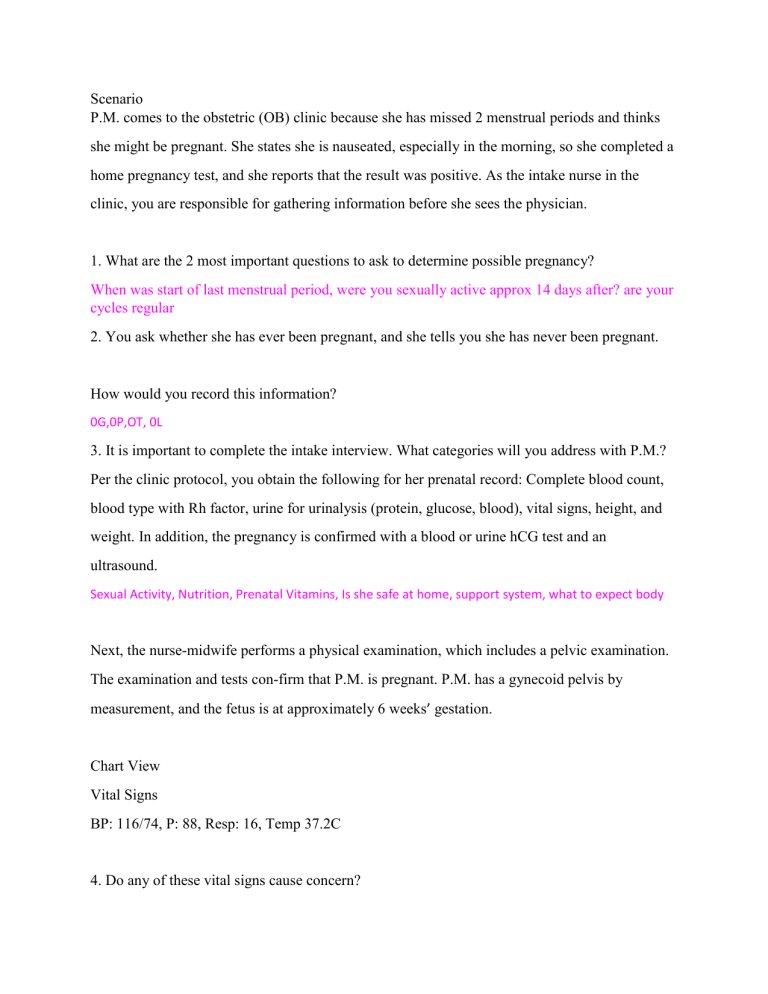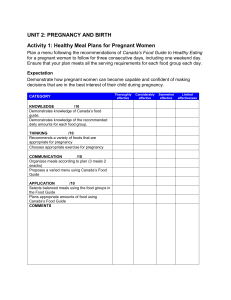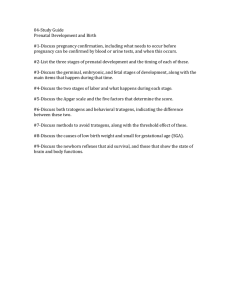
Scenario P.M. comes to the obstetric (OB) clinic because she has missed 2 menstrual periods and thinks she might be pregnant. She states she is nauseated, especially in the morning, so she completed a home pregnancy test, and she reports that the result was positive. As the intake nurse in the clinic, you are responsible for gathering information before she sees the physician. 1. What are the 2 most important questions to ask to determine possible pregnancy? When was start of last menstrual period, were you sexually active approx 14 days after? are your cycles regular 2. You ask whether she has ever been pregnant, and she tells you she has never been pregnant. How would you record this information? 0G,0P,OT, 0L 3. It is important to complete the intake interview. What categories will you address with P.M.? Per the clinic protocol, you obtain the following for her prenatal record: Complete blood count, blood type with Rh factor, urine for urinalysis (protein, glucose, blood), vital signs, height, and weight. In addition, the pregnancy is confirmed with a blood or urine hCG test and an ultrasound. Sexual Activity, Nutrition, Prenatal Vitamins, Is she safe at home, support system, what to expect body Next, the nurse-midwife performs a physical examination, which includes a pelvic examination. The examination and tests con-firm that P.M. is pregnant. P.M. has a gynecoid pelvis by measurement, and the fetus is at approximately 6 weeks’ gestation. Chart View Vital Signs BP: 116/74, P: 88, Resp: 16, Temp 37.2C 4. Do any of these vital signs cause concern? Nothing to concern 5. P.M. tells you that the date of her last menstrual period (LMP) was February 2. How would you calculate her due date? What is her due date? November 9 6. What is the significance of a gynecoid pelvis? Assessing pelvis for potential in-capatibility for head size of baby 7. What specimens are important to obtain when the pelvic examination is done? STI swabs, urine test - proteins, uti, candida albacans CASE STUDY PROGRESS development and detecting potential complications. Educating P.M. about the importance of proper nutrition, managing the common discomforts of pregnancy, and activities of selfcare will help in the wellbeing of her and her baby.8. A psychological assessment is done to determine P.M.’s feelings and attitudes regarding her pregnancy. How do attitudes, beliefs, and feelings affect pregnancy? PM's feelings of security, support, cultural food etc, stress can have effect on development, nutrition 9. P.M. asks you whether there are any foods she should avoid while pregnant. She lists some of her favorite foods. Which foods, if any, should she avoid eating while she is pregnant? Select all that apply. a. Sushi b. Yogurt c. Hot dogs d. Deli meat e. Cheddar cheese 10. As the nurse, you understand that assessment and teaching are vital in the prenatal period to ensure a positive outcome. What information is important to include at every visit and at specific times during the pregnancy? Water, Nutrition, obstain from A&D, take nutrition, assess mental health, 11. After her examination, P.M. states that she is worried because her sister had an ectopic pregnancy and had to have surgery. She asks you, “What are the signs of an ectopic pregnancy?” Identify the correct response. Select all that apply. a. Nausea b. Increased fatigue c. Dark red or brown vaginal bleeding d. Fullness and tenderness in her abdomen, near the ovaries e. Pain, either unilateral, bilateral, or diffuse over the abdomen 12. P.M. asks the nurse about what should be reported to her doctor. List at least 6 of the danger signs during pregnancy. Bleeding, Pain, extreme nasuea (IE not holding anything down, danger of dehydration, malnutrition, fever, weight loss, edema, dizzy/lightheaded) 13. Common changes in the body caused by pregnancy include relaxation of joints, altered center of gravity, syncope, and generalized discomfort. These changes can lead to problems with coordination and balance. After a teaching session about safety measures, you use the Teach-Back technique to assess P.M.’s understanding. Which statement by P.M. indicates a need for more teaching? a. “I will take rest periods throughout the day.” b. “I will always wear a helmet when riding my bike.” c. “I will avoid activities that cause sudden, jarring moves to my body.” d. “Later in my pregnancy, I won’t use a seatbelt in the car because I’ll be too big.” 14. P.M. asks, “Is a vaginal examination done at every visit?” Select the best response and provide a rationale for your answer. a. “No, a vaginal examination will not be done again until you go into labor.” b. “No, vaginal examinations are not routinely done until the final weeks of your pregnancy.” c. “Yes, an examination is done with each visit because it offers vital information about the status of the pregnancy.” CASE STUDY OUTCOME





